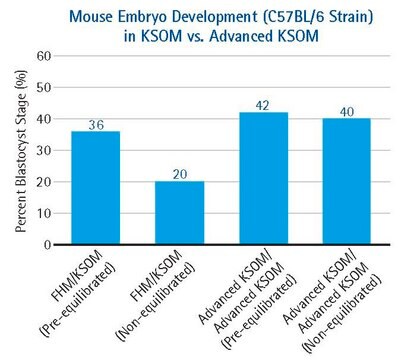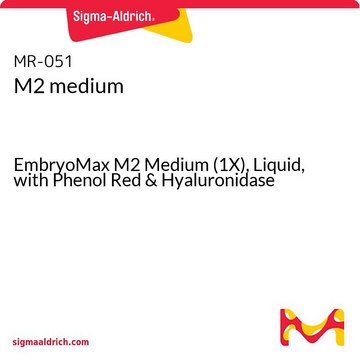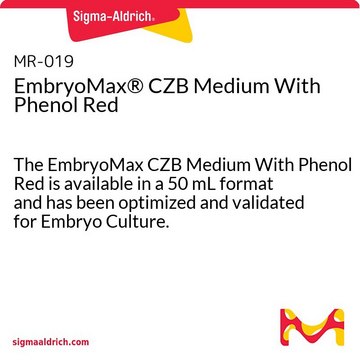M7167
M2 medium
With HEPES, without penicillin and streptomycin, liquid, sterile-filtered, suitable for mouse embryo cell culture
Synonym(s):
Cell Culture M2, Cell Culture Medium, M2 Medium Solution
About This Item
Recommended Products
sterility
sterile-filtered
form
liquid
storage condition
protect from light
technique(s)
cell culture | embryo: suitable
impurities
endotoxin, tested
components
HEPES: 5.42726 g/L
NaHCO3: 0.35 g/L
glucose: 1.0 g/L (Dextro)
phenol red: 0.0106 g/L
sodium pyruvate: 0.0363 g/L
shipped in
ambient
storage temp.
2-8°C
Looking for similar products? Visit Product Comparison Guide
Application
M2 Medium is a further modification of M16 that substitutes HEPES buffer in place of some of the bicarbonate. M2 is used for collecting and handling embryos for prolonged periods outside a CO2 incubator.
Quality
Reconstitution
Analysis Note
recommended
Storage Class Code
10 - Combustible liquids
WGK
WGK 3
Flash Point(F)
Not applicable
Flash Point(C)
Not applicable
Certificates of Analysis (COA)
Search for Certificates of Analysis (COA) by entering the products Lot/Batch Number. Lot and Batch Numbers can be found on a product’s label following the words ‘Lot’ or ‘Batch’.
Already Own This Product?
Find documentation for the products that you have recently purchased in the Document Library.
Customers Also Viewed
Articles
Mouse embryo media and embryo validated reagents for transgenic mouse embryo culture
Protocols
Creating Transgenic Mice using CRISPR-Cas9 Genome Editing
Our team of scientists has experience in all areas of research including Life Science, Material Science, Chemical Synthesis, Chromatography, Analytical and many others.
Contact Technical Service











